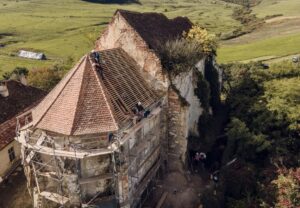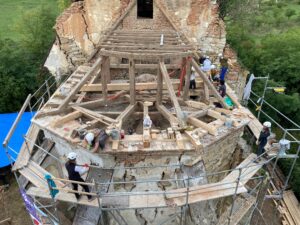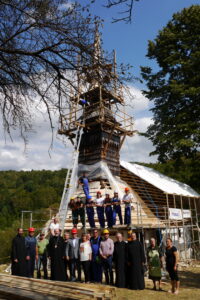
Team working in Hilișeu-Horia. © Asociatia Monumentum
The Ambulance for Monuments was launched in 2016 in Romania to save endangered historic monuments with the support of volunteers, heritage experts, local communities and administrations. The project is designed to work in the same way that an ambulance for humans: a fully equipped vehicle comes on site, the experts assess the damage and stabilise the patient, and then a team works to return the patient to a healthy state. We recently had a chat with the creator of this successful formula and finalist of the Religious Heritage Innovator of the Year, Eugen Vaida, to learn more about the beginnings of the project and how it has grown to become a national phenomenon in Romania.
First of all, can you tell us about how the project was born?
This all started in 2016 when we noticed that there were hundreds of endangered buildings which were listed and despite this, they were collapsing. At that time we thought “we cannot wait for the state to do more for the buildings, we should do it ourselves”.
So we gathered a few volunteers for whom we got a lorry funded by an international organisation. Some of them came to my house and we offered them accommodation. I remember they slept in the kitchen, the bathroom and everywhere in the house. The first day when we should start the work, the lorry cracked on the road. So I think this is one of those projects whose story starts even before the official beginning. The original idea started very small and with few resources, and then progressively grew into something bigger.
Despite this start, my colleague and I liked the idea of getting in a van and saving monuments. Then she said, “we must do this type of project”. So we set it up as a pilot project of Asociatia Monumentum. We already had the experience and a car with a trailer. We just needed a name, a logo, and more vans equipped with tools. All this in the end brought the project to another level.
So officially we started The Ambulance for Monuments in 2016, but our work had already started a bit sooner.
How many places have you intervened in all these years?
So far we have managed to save 85 historic buildings, most of which are churches, as these are the most numerous on the list of monuments. We also have had manor houses, bridges, and some water mills.
For all these interventions, you have found a way to involve different actors in a harmonious and coordinated way.
Yes, and this is actually the winning recipe. We involve all the actors that contribute to the preservation of built heritage.
First of all, there is the NGO, which has the leading role and the initiative, the glue that binds the other actors together. Secondly, we have the owner or town hall. Most of the listed buildings in Romania are publicly owned, so the administrations cover the cost of materials. In third place, we have the local community, the actor who is hosting and feeding us. And last but not least important, we have a community of experts and craftsmen who lead the work and offer on-site training to the volunteers.
So we managed to find the right kind of contribution for each of these four actors. Each one does what he or she does best, what he or she is competent to do.

Church in Vermes. © Asociatia Monumentum
Do you monitor the buildings you intervene in any way to ensure that they are kept in good condition?
The most important for us when we start is, of course, to save endangered buildings. But we soon realised that without the support of a community and qualified people, in 20 years it will be us again who need to repair them and the situation will not be sustainable. So then we started to involve the local community more to take care of these buildings.
We provide them with expertise. The interventions are just for two, three or four weeks and then we leave. But we want to see that the owner or the local community maintain what we did there, or that they even start major restorations and repairs and reuse the building in any way.
So even though we don’t have the capacity to monitor the buildings yet, we are trying to evaluate our impact in the communities to see what works, which are the triggers or the buttons we need to push to engage the community more and also how we can make the involvement more structured after we leave.
Because our interventions offer, let’s say, “first aid” to the building. It is mainly a matter of repairing the roof, correcting the drainage, solving structural problems in the foundations, and so on. This is our first objective. But we have four others.
What are these other four objectives?
One of the most important is the educational aspect. We want to train new young experts because Romania and Eastern Europe are in need of them. We have quite a lot of European funds which are coming in and there are no experts to deal with all these funds. Sometimes it happens that there are projects for which there is money, but you can’t find experts.
This year we have around 500 students, mainly from the fields of architecture, archaeology, engineering, art history, urban planning and tourism. People from all disciplines that are involved in one way or another in the preservation of heritage. The training goes from spring to autumn, because this is seasonal work. In winter we are busy preparing the documentation, signing partnerships, raising funds and so on.
The third objective is to revive traditional crafts and also emergent crafts. We do not want to “freeze” traditional craftsmanship. We want to see how they can be developed and adapted to the new times. So we are involving as many local craftsmen as possible. There are not so many, so sometimes we need to bring them from far away. But we prefer to do some small research before, like a survey, to see if we can find craftsmen in the village where we are working, because they might know special details and how these buildings have been built.
As a fourth objective, there is the need to involve the local community, make them aware of this cultural asset and explain to them why it’s important to preserve it. That it’s also part of their history and it can be part of an infrastructure for education for the children in the village. We often invite them to come and see what we are doing and to understand a little bit more about the building. Sometimes it’s also about convincing them that this heritage doesn’t belong to a private owner, but it’s rather an ownership of the entire community and the region.
The fifth objective is to develop the issue of volunteering in Romania and to convince policymakers to fund the restoration and conservation of built heritage, which is lacking in our country. Not everyone has access to work with European funds. But the Ambulance for Monuments is open to any Romanian who wants to volunteer. Of course, we give priority to students and young specialists for whom this volunteering can be part of their professional training.

Team working on the restoration of a church in Vermes. © Asociatia Monumentum
With how many volunteers can you work in a season from spring to autumn?
We’re expecting this year around 600 volunteers for 17 new sites. This means an average of 30-40 participants per intervention, who attend for an average of one week each. Some of them stay longer. We have volunteers who have spent the entire summer on the working sites.
Actually, most of our current coordinators and assistants are former volunteers who are now trained professionals who want to continue getting involved with us.
In this way, we do not need to look for other experts outside the project. This is also about sustainability. We provide training to the people we work with at the beginning so that they can continue to contribute to the project as trained professionals.
The Ambulance for Monuments started in one specific region of Romania, but now you have different branches, right?
Yes, it works like a franchise system. We started in southern Transylvania, where we had this capacity. And then we just shared the formula with other organisations. We also helped to set up other NGOs in different regions of Romania. Nowadays we are nine ambulances. Five of them have been set up and supported by us. The other four were existing NGOs that joined the project.
We realised that we cannot always manage to make an intervention very far away from our region, because we don’t have as much knowledge of these areas. S with these organisations, we have a Memorandum of Understanding, which says that we support them with half of the funds for the running costs of the interventions and we also provide them with tools, scaffolding, equipment, whatever is needed, and the van.
Each of the ambulances is doing two interventions a year. Here in our region, we have a bigger capacity so we are doing more intervention. In total, between 17 and 20 interventions each year.
That seems like a good number of buildings saved per year considering your current capacity…
At this moment we have around 800 buildings which are in need of urgent repair. So we are doing something, but heritage needs much more. We are trying to convince the local authorities, the regional ones and also the national government, to support this kind of work and also to set up their own projects and collaborate, because there should be more entities preserving heritage, not just the Ambulance.
Sometimes we feel a lot of pressure because in Romania, many people know about us and they think that the Ambulance is a state project. So they tell us “you need to come here, you are the Ambulance for Monuments, why are you not coming?” And then we need to explain that we don’t have the capacity to help all the buildings and that there are some criteria because we need to prioritise.
What are these criteria?
The first criterion is the cultural value of the building. We have worked on many endangered UNESCO sites in Romania. The second criterion is the involvement of the local community, which brings the sustainable component to the intervention. And the third, of course, is the state of degradation, because it depends on whether the building is more or less in danger of collapse. Sometimes it is not just a matter of it collapsing, but the rain may be damaging valuable paintings inside, so that the building is not in danger of collapsing, but of losing a significant part of its artistic value.

Team working in Lusoara. © Asociatia Monumentum
Do you consider expanding the network in the future?
For now, we are covering 60% of Romania. We have certain requests from organisations in different parts of the country. But in the future we will develop a bit more slowly because we want to keep this going well and maintain high quality.
In the beginning, we were repairing small buildings, but now there are huge sites. The pressure is higher as we take more difficult interventions. The owners are more demanding, and they have bigger problems which we need to face. This is a challenge for us.
We are working very well with local administrations and County Councils. But I think there is a lot of bureaucracy working with the national government and it’s on a different scale that we don’t feel as grassroots as our project. So it’s difficult to combine the two visions.
Have you been approached by any foreign organisations to replicate the same Ambulance formula in their regions?
Yes, there are some, but we decided that we first want to cover the whole national territory and make it work in all the regions. So first we will focus on Romanian heritage and then go on an international scale.
We are in contact with many organisations, some of them doing similar things within the field they are specialised in. For example, the Monumenten Wacht in the Netherlands. They have inspectors, they advise a lot and they give some diagnostics for buildings. Then there is the Prince Claus Fund, which has also emergency interventional programs, and cares about training and involving local communities. And in the Balkans, there is the Heritage without Borders project, which was started through an initiative coming from Sweden after the war in Bosnia-Herzegovina.
There is so much we could learn from built heritage, it is possibly the best infrastructure for education. It is not just a social responsibility to preserve our own cultural identity or the cultures of others but it could bring also great fun to someone who wishes to develop his manual skills to understand culture through hands-on activities. Everyone has a place in the field of preservation of built heritage, this is a fact.





Follow us: